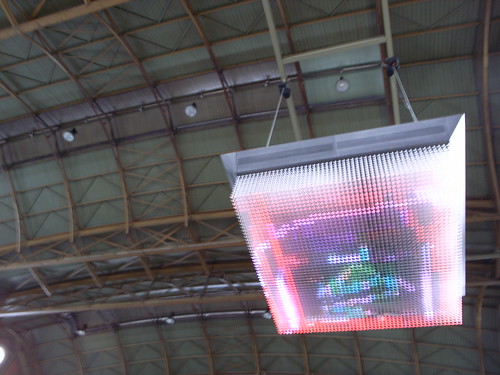 (an interactive display at Zürich train station)
(an interactive display at Zürich train station)
In his chapter called "Extreme Informatics: Toward the De-saturated City" (taken from "Handbook of Research on Urban Informatics: The Practice and Promise of the Real-Time City" by Marcus Foth), Mark Shepard offers an insightful critique of urban screens. He basically posit that they operate as "skeuomorph" in the evolution of urban informatics.
The notion of "skeuomorph" is taken from Hayles who borrowed it from anthropology to describe transitional objects and meme in the context of cybernetic theory:
"In archaeology, skeumorphs are material artifacts that simulate an aspect of a previous time using a technology that has superseded it. They are derivative objects that retain structurally necessary elements of the original as ornamentation, stripped of their original function. Skeuomorphs are often deliberately employed to make the “new” look familiar, comfortable and accessible. Examples include the simulated stitching of the vacuum formed vinyl replacing the fabric upholstery of car interiors, the mechanical shutter sound produced by digital cameras, or more abstractly, the metaphor of the “desktop” work-space of the personal computer introduced by Apple with the Macintosh computer in 1984, where the organizational syntax of files and folders serves to orient us within an otherwise unfamiliar space"
For Shepard, these transitional artifacts enable to soften the transition between technological phases. As he points out, "Artifacts (and by extension ways of thinking) of one moment are carried forward into the future by simulating aspects of the past". Quite an inspiring quote I think.
Using this notion, he then explains how urban displays are based on a longstanding model of information access and distribution in public space that is old (and flawed): the fact that we need to access MORE information (and that it should be broadcasted to a "public"):
"I would argue that the paradigm of large-scale “urban screens” operates as a skeumorph in the evolution of urban informatics. It is based on conceptual categories whose relevance vis-à-vis contemporary societies is questionable. While this paradigm may serve to smooth the transition of integrating digital information systems into urban environments, it does so by reproducing modes of information access and distribution that no longer hold sway. In doing so, it perpetuates design logics regarding “the public” and “public space” that are perhaps less reflective of the way we access, share and distribute information today."
The paper also offers an interesting exploration of other strategies for urban computing/informatics to offer alternatives.
Why do I blog this? I have to admit that I am often on the look out for such theoretical constructs that enable to reflect on technological design. The notion of "skeuomorph" seems relevant and largely applicable to other fields. It's surely important to use in a course I am preparing for next week about innovation and foresight.